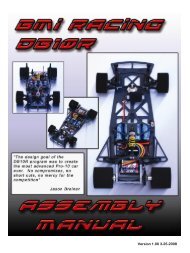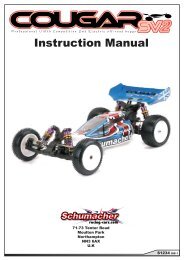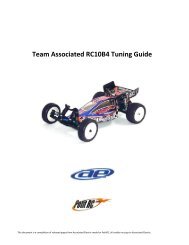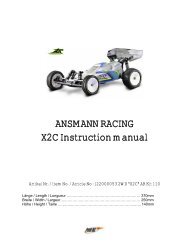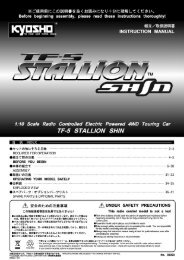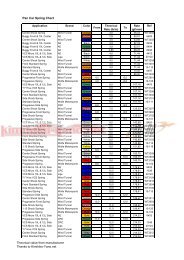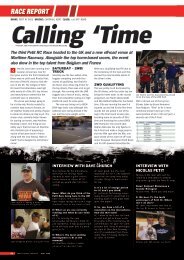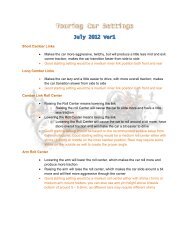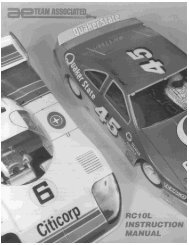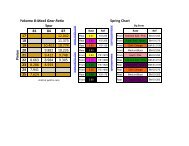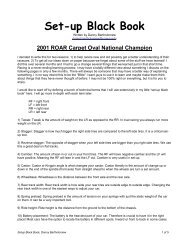XRAY T3 Set-up Book - Petit RC
XRAY T3 Set-up Book - Petit RC
XRAY T3 Set-up Book - Petit RC
You also want an ePaper? Increase the reach of your titles
YUMPU automatically turns print PDFs into web optimized ePapers that Google loves.
FRONT & REAR AXLES<br />
One-Way Axles<br />
There are two types of one-way axles for use in an R/C car. The most common is a front one-way axle; the other is a central one-way pulley.<br />
Front One-Way Axle<br />
Standard One-Way<br />
Outdrive shaft<br />
(Right)<br />
Spacer<br />
Front main axle<br />
Spacer<br />
Cutaway view<br />
Outdrive shaft<br />
(Left)<br />
When using an <strong>XRAY</strong> Multi-Diff in “one-way” mode, outdrive shafts (left and right) are not connected to each other, nor to front main axle.<br />
This mode combines the characteristics of a solid axle and a differential.<br />
Off-power & braking<br />
(corner entry & mid-corner):<br />
On-power<br />
(mid-corner and corner exit)<br />
Best used with:<br />
Best used when:<br />
Front inner and outer wheels rotate forward independently of each other, making axle behave like a front ball<br />
differential. There is NO front braking.<br />
Both front wheels rotate with front main axle (locked in one-way bearings) at the same speed, making axle<br />
behave like a front solid axle. Introduces some on-power understeer.<br />
rear differential or solid rear axle.<br />
traction is high, the car leans towards off-power understeer and the track does not require braking for<br />
the corners. Will give maximum off-power steering and increase efficiency (more runtime). Best suited to a<br />
smooth driving style.<br />
The front one-way axle allows you to use slightly bigger rear tires than front tires, and to have the rear wheels overdrive the front wheels. In that<br />
situation, when the rear wheels lose traction the front wheels engage and start helping to generate forward traction.<br />
Considerations: It is very important to know that when using a front one-way axle, you get no front wheel braking. While this gives you better<br />
steering response going into a corner, the effect may cause the rear of the car to break traction more easily.<br />
One-Way Pulley<br />
The optional one-way pulley for the <strong>T3</strong> is a pulley on a one-way bearing, which rides on the central layshaft. This pulley is connected to the front<br />
axle. The one-way pulley allows the front wheels to spin independently from the rear wheels.<br />
The adjustable one-way pulley is used to set how freely the front axle turns in relation to the rear axle. You can tighten the adjustment of the one-way<br />
pulley on the layshaft; from fully-tightened to lock the front wheels to the rear (full-time 4WD) to fully-loosened to let the front free wheel off-power<br />
(4WD on-throttle, RWD off-throttle). Or it can be set somewhere in between to match your driving style.<br />
Effects of One-Way Pulley Adjustment<br />
Looser<br />
Tighter<br />
· More off-power steering.<br />
· Less drive train drag at maximum speed.<br />
· Increased top speed.<br />
· Should only be used on high traction surfaces or large<br />
tracks where minimal braking is required. Since only the<br />
rear wheels are used for braking, spins induced by a<br />
locked rear tire are more likely.<br />
· Lessens steering.<br />
· Better braking.<br />
· More drive train drag.<br />
· Better under slippery conditions.<br />
Front One-Way Axle vs. One-Way Pulley<br />
When using a front differential and a one-way pulley, you still get<br />
differential action under acceleration. That means that when going<br />
through a corner on-throttle, if the inside wheel breaks traction it<br />
can still “unload” and prevent the outer wheel from getting any<br />
power. A front one-way axle gets around this problem by giving<br />
each wheel its own independent one-way bearing. That way, the two<br />
wheels can rotate at different rates, like with a regular differential,<br />
but on-throttle, if one wheel loses traction, the other one still gets<br />
power to pull the car through the corner.<br />
Keep in mind that when using the one-way pulley with a loose<br />
setting or when using the front one-way axle, no drag brake should<br />
be used. Most racers will also find it more convenient to set their<br />
radio to give less braking action (use the throttle EPA setting); this<br />
will prevent the rear tires from locking unexpectedly.<br />
Use table below as a general guideline for the use of a front one-way axle<br />
and one-way pulley.<br />
Track surface<br />
One-Way Pulley<br />
Tight<br />
Loose<br />
Low traction<br />
ü<br />
Medium traction<br />
(slow, tight corners) ü ü<br />
High traction<br />
(slow, tight corners)<br />
High traction<br />
(fast, sweeping corners)<br />
ü<br />
Front One-Way Axle<br />
ü<br />
39



